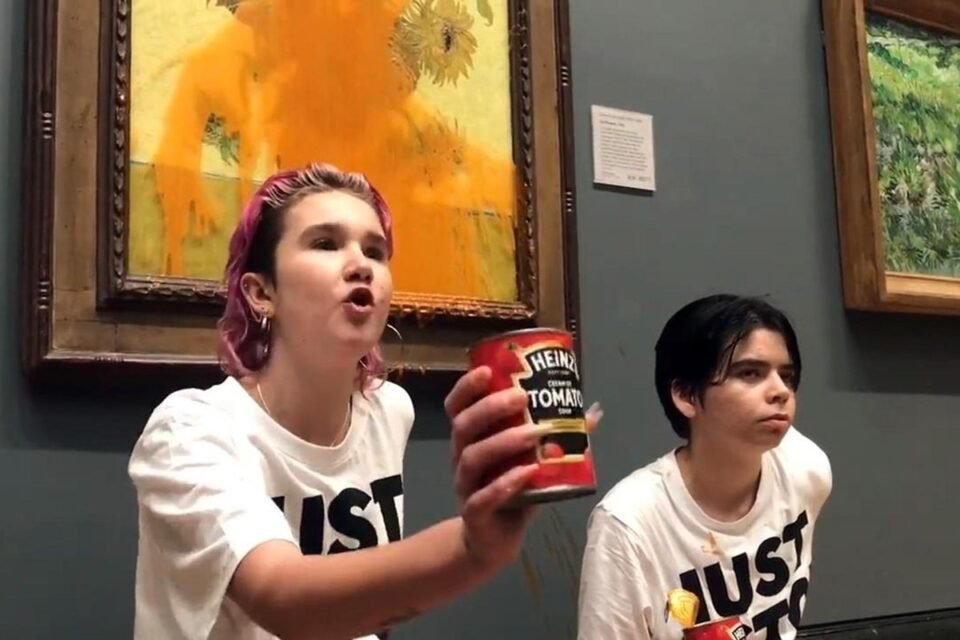Last week, two Just Stop Oil activists – and Dazed cover stars – were jailed for throwing soup on Vincent van Gogh’s Sunflowers at the National Gallery. Phoebe Plummer (23) received a sentence of two years, while Anna Holland (22) is set to serve 20 months behind bars. Needless to say, this feels excessive for a protest action that only damaged the painting’s frame, and it’s hard to imagine that the decision wasn’t swayed by an ongoing crackdown on civil resistance in the UK. But it also ignores a broader history of protests that helped fight for the freedoms we do enjoy today.
From suffragettes slashing canvases, to anti-war activists using Guernica as a vehicle for their messages of peace, art has often been in the firing line when it comes to political dissent. This makes sense. Picassos and Da Vincis are some of the world’s most expensive, venerated, and high-profile objects – deface them, and the whole world pays attention. And what really matters more, a pricey picture, or like… human rights? As Pussy Riot’s Nadya Tolokonnikova recently wrote in the Guardian: it’s doubtful that van Gogh would have been that worried about his work being caught in the crossfire, if he saw the world burning all around him.
As Just Stop Oil protestors face prison time, we’ve gathered some of the most famous works of art damaged during acts of protest, to put things in perspective.

Defacing an artwork doesn’t necessarily mean that you disagree with the artist’s original message. Take the vandalism of Picasso’s Guernica in 1974, during the tail end of the Vietnam War. One of the world’s most famous anti-war artworks was daubed with the words “KILL LIES ALL” by art dealer Tony Shafrazi, as a protest against the release of lieutenant William Caley, who had been convicted for his involvement in the My Lai massacre, a war crime committed by the US Army in 1968.
Shafrazi handed himself over and was tried for criminal mischief but was let off on probation (he’d go on to champion the likes of Warhol, Basquiat, and Keith Haring). The painting itself was easily cleaned thanks to a thick layer of varnish.

Late last year, two Just Stop Oil activists smashed the glass on a National Gallery painting by Diego Velázquez, The Toilet of Venus (AKA the Rokeby Venus). Almost 110 years before that, though, Canadian suffragette Mary Richardson took a meat chopper to the panting, managing to make five slashes in the canvas. She was campaigning against the arrest of Emmeline Pankhurst, telling the press that she’d targeted a depiction of the “most beautiful woman in mythological history” to reflect Pankhurst’s beautiful character. Richardson went on to be a fascist supporter of Oswald Mosley, but the less said about that the better.

Leonardo Da Vinci’s Mona Lisa – AKA the most famous painting in the world – travelled to Japan for an exhibition in 1974, but there was a problem. With more than a million people going to see the painting, Tokyo’s National Museum denied entry to people who needed assistance, claiming it was a necessary measure for crowd control. This led to a campaign by disability activists, which came to a climax when 25-year-old Tomoko Yonezu tried to spray the picture red on opening day. Only a few dozen droplets of paint made it onto the masterpiece, which was easily repaired. Yonezu, meanwhile, faced a 3,000 yen fine, but the act was largely deemed a success when the museum set aside a day exclusively for disabled visitors.

In June 2024, Just Stop Oil caused controversy once again, by coating the ancient monument – or… whatever it is – Stonehenge with orange pigment. In fact, this was one of the group’s most divisive actions to date in their fight to stop burning fossil fuels, with druids, gammon-faced geezers, and senior Tories finding a rare common ground in denouncing the demonstrators. Of course, the cornflour-based powder paint wasn’t permanent, and specialists managed to wash it off with a glorified hairdryer. “Oh but if it rained it could have damaged the rare lichens!” But it didn’t, so guess we’ll never know x
You didn’t think we were going to leave out Phoebe and Anna, did you? The pair originally doused Vincent’s 1888 painting in tunned tomato soup in 2022, sparking outrage in the National Gallery. They then proceeded to superglue their hands to the wall, and asked gallerygoers: “What is worth more, art or life? Is it worth more than food? Worth more than justice? Are you more concerned about the protection of a painting, or the protection of our planet and people?”
“Seeing the impact it had […] felt more crazy than actually throwing the soup,” Plummer told Dazed of the action, in a 2023 cover interview. And they weren’t wrong: since September 2022, the action has sparked conversations about climate justice up and down the nation, at all levels of life. The pair were ready to face the consequences, as well. “We’re not going to be intimidated by prison sentences when there’s so much more at stake,” Plummer added in their interview. “When the only future I see for myself is one of mass famine, severe droughts, flooding, wildfires and societal collapse, time spent in prison is irrelevant.”

